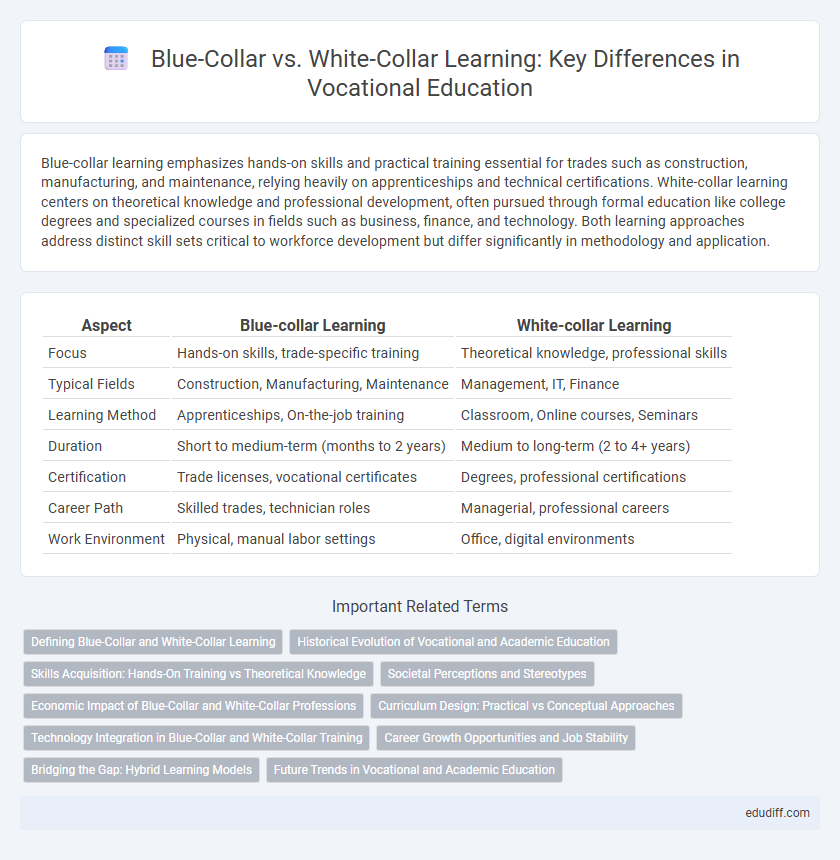Blue-collar learning emphasizes hands-on skills and practical training essential for trades such as construction, manufacturing, and maintenance, relying heavily on apprenticeships and technical certifications. White-collar learning centers on theoretical knowledge and professional development, often pursued through formal education like college degrees and specialized courses in fields such as business, finance, and technology. Both learning approaches address distinct skill sets critical to workforce development but differ significantly in methodology and application.
Table of Comparison
| Aspect | Blue-collar Learning | White-collar Learning |
|---|---|---|
| Focus | Hands-on skills, trade-specific training | Theoretical knowledge, professional skills |
| Typical Fields | Construction, Manufacturing, Maintenance | Management, IT, Finance |
| Learning Method | Apprenticeships, On-the-job training | Classroom, Online courses, Seminars |
| Duration | Short to medium-term (months to 2 years) | Medium to long-term (2 to 4+ years) |
| Certification | Trade licenses, vocational certificates | Degrees, professional certifications |
| Career Path | Skilled trades, technician roles | Managerial, professional careers |
| Work Environment | Physical, manual labor settings | Office, digital environments |
Defining Blue-Collar and White-Collar Learning
Blue-collar learning centers on hands-on skills and technical training essential for trades such as manufacturing, construction, and maintenance, emphasizing practical experience and apprenticeships. White-collar learning focuses on acquiring theoretical knowledge and professional skills relevant to office-based roles, including management, finance, and administration, often delivered through formal education and corporate training programs. These distinct approaches align with the specific demands and environments of blue-collar and white-collar occupations, shaping targeted vocational education strategies.
Historical Evolution of Vocational and Academic Education
Vocational education historically emphasized hands-on, blue-collar skills tailored for trades like manufacturing, construction, and maintenance, contrasting with white-collar learning centered on academic, theoretical knowledge for office-based professions. The Industrial Revolution marked a significant shift by increasing demand for skilled laborers, leading to the formalization of vocational training through apprenticeships and technical schools. Meanwhile, academic education evolved to prioritize intellectual disciplines, eventually shaping distinct educational pathways that reflect the socioeconomic divide between blue-collar and white-collar careers.
Skills Acquisition: Hands-On Training vs Theoretical Knowledge
Blue-collar learning prioritizes skills acquisition through hands-on training, emphasizing practical experience and direct application in trades like welding, carpentry, and electrical work. White-collar learning often focuses on theoretical knowledge, critical thinking, and conceptual understanding essential for professions such as management, law, and finance. This distinction shapes vocational education approaches, with blue-collar programs providing technical proficiency and white-collar programs fostering analytical and strategic competencies.
Societal Perceptions and Stereotypes
Blue-collar learning is often associated with hands-on skills and practical experience, while white-collar learning emphasizes theoretical knowledge and formal education. Societal perceptions tend to stereotype blue-collar workers as less educated, despite their technical expertise and crucial role in the economy. These stereotypes influence career aspirations and wage disparities, reinforcing social divides between vocational trades and professional occupations.
Economic Impact of Blue-Collar and White-Collar Professions
Blue-collar learning often emphasizes hands-on skills and technical training, driving economic growth through manufacturing, construction, and essential services that support infrastructure and daily operations. White-collar learning focuses on analytical, managerial, and professional expertise, contributing significantly to sectors such as finance, technology, and healthcare, which generate high-value economic outputs. The balance between blue-collar and white-collar professions shapes labor market dynamics, influencing wage distribution, employment rates, and overall productivity in the economy.
Curriculum Design: Practical vs Conceptual Approaches
Vocational curriculum design for blue-collar learning emphasizes hands-on, practical training that aligns directly with specific trades and industry skills, ensuring immediate job readiness. White-collar learning typically incorporates conceptual approaches that develop critical thinking, problem-solving, and theoretical knowledge applicable across various professional fields. Balancing experiential exercises in blue-collar programs with analytical frameworks in white-collar education enhances the effectiveness of vocational training tailored to diverse workforce demands.
Technology Integration in Blue-Collar and White-Collar Training
Technology integration in blue-collar training emphasizes hands-on simulations, augmented reality, and wearable devices to enhance skill acquisition and safety compliance. White-collar learning leverages digital platforms, artificial intelligence, and virtual collaboration tools to facilitate complex problem-solving and continuous professional development. Both sectors benefit from adaptive learning technologies, but blue-collar training prioritizes practical application while white-collar focuses on cognitive skills enhancement.
Career Growth Opportunities and Job Stability
Blue-collar learning emphasizes hands-on skills and technical expertise, often leading to career growth through apprenticeships, certifications, and direct experience in trades like plumbing, electrical work, and manufacturing. White-collar learning typically involves formal education and professional development in fields such as finance, marketing, and technology, offering advancement through degrees, management training, and specialized knowledge. Job stability in blue-collar careers depends on demand for skilled labor and union strength, while white-collar job stability correlates with industry trends, economic cycles, and continuous upskilling in emerging technologies.
Bridging the Gap: Hybrid Learning Models
Hybrid learning models combine hands-on blue-collar training with theoretical white-collar education to address skill gaps in vocational fields. These models integrate practical workshops with digital coursework, enhancing skill acquisition and adaptability for diverse job roles. By leveraging technology and experiential learning, hybrid programs improve workforce readiness and career mobility across industries.
Future Trends in Vocational and Academic Education
Future trends in vocational and academic education emphasize the integration of digital skills and adaptive learning technologies tailored for both blue-collar and white-collar sectors. Blue-collar learning increasingly incorporates automation, robotics, and augmented reality to enhance hands-on training efficiency and workplace safety. White-collar education focuses on advanced data analytics, artificial intelligence, and remote collaboration tools to prepare professionals for evolving knowledge-based economies.
Blue-collar learning vs White-collar learning Infographic

 edudiff.com
edudiff.com